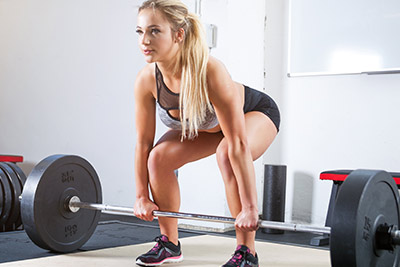 The deadlift is a classic strength exercise for good reason: it works most major muscle groups and can be modified to fit your fitness level. To help bring new life to this fan favorite, here are several variations to keep your body guessing, target different muscles, avoid overuse injuries and help you be fit. But first, let’s go over the conventional deadlift with an eye on its benefits and technique.
The deadlift is a classic strength exercise for good reason: it works most major muscle groups and can be modified to fit your fitness level. To help bring new life to this fan favorite, here are several variations to keep your body guessing, target different muscles, avoid overuse injuries and help you be fit. But first, let’s go over the conventional deadlift with an eye on its benefits and technique.
The Basic Deadlift
The deadlift is one of the most popular strength exercises because it also is one of the most effective. As a compound, or multi-joint, move (meaning it works more than one joint at a time) it’s especially useful for training the lower body, involving hips, knees and ankles.
This in turn increases the focus on technique, especially for engaging your core (which is great for your abs, glutes and back) and aligning your joints (which is great for posture and balance).
Happily, all this work and attention pays off with the deadlift, since you’re recruiting more muscle than single-joint moves can do on their own.
If you’re new to deadlifting, start with the basics, with an empty barbell. Once you perfect your form, add weight, and then add variations to help progress your workouts.
- Stand with feet, hip-width apart, weight/bar in front of you.
- Bend your knees and reach down toward the bar with your palms facing you, so your arms are vertical to the floor.
- Keep your back as straight as possible, your chest upright and your head in line with your neck as you lean forward and grab the bar.
- Hold your abs, lift the bar and squeeze your glutes as you straighten up to stand, your bodyweight driven into your heels. Keep the bar close to your body.
- Reverse the move to lower the bar down, then return to the starting position.
- Perform short sets (1 – 4) of fewer reps (4 – 6).
Not sure your form is correct? Click here to request a complimentary Personal Training Session for additional help.
Deadlift Variations
Depending on the variation and stance you choose, your deadlifting can bring some extra work to your hamstrings, quads, back … even your arms. Which deadlift is best? A variety is a great idea, to help you build nearby and smaller muscle groups, perhaps to add weight and mass, and to avoid overworking some of the large muscle groups of the classic deadlifts.
Your lower body has a large expanse of muscle, and the more muscle fibers you recruit, the more effective your workouts will be! You can change the position of your stance as well as the weights, and even work your way up to single-leg versions when you’re ready.
Below are four deadlift variations you can use to bring new life to your workouts. We recommend checking with a trainer to help you perfect the form and avoid injury if you’d like to progress to more challenging lifts!
Dumbbell Deadlift. Just like it sounds, instead of a barbell, you’ll use dumbbells—one placed on the outside of each of your feet in your stance. This variation lets you engage your lats and scapular area more than the conventional deadlift. You also gain the benefits of working on unilateral balance, and you’ll feel a more balanced pull between hamstrings and quads, too.
Sumo Deadlift. This version uses an extra-wide plie (sumo) stance with the hips and toes turned open. It has a shorter range of motion and is a good choice for shorter folks who may be thicker in the middle, and for those with less ankle mobility. It also takes some of the pressure off your spine and activates your hips more.
Romanian Deadlift. This alteration from the basic deadlift is in the stance and legs. The foot stance a little narrower with the back very flat and knees are just barely bent. This requires additional flexibility, and as a result can put more strain on the low back. That’s why more moderate weights and sets are a wise choice—go light on that hamstring stretch at first!
Single-Leg Romanian Deadlift. You guessed it, a very advanced move is created when the deadlift stance moves from two feet to one. It’s amazing for the glutes and a challenge to core stability. No weights needed to learn this one, and you can balance your toe behind you on a bench to get the hang of it.


